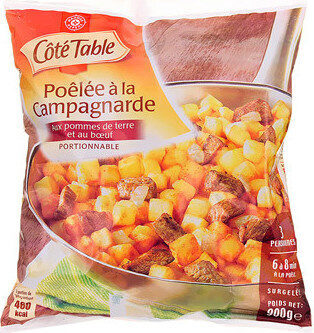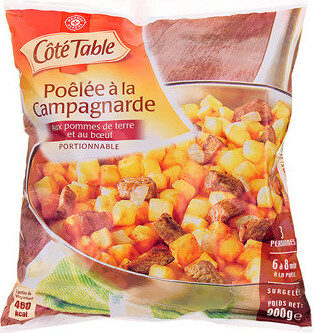Poêlée à la Campagnarde - Marque Repère - 900 g
This product page is not complete. You can help to complete it by editing it and adding more data from the photos we have, or by taking more photos using the app for Android or iPhone/iPad. Thank you!
×
Some of the data for this product has been provided directly by the manufacturer Scamark.
Barcode: 3564700259009 (EAN / EAN-13)
Quantity: 900 g
Packaging: Bag
Brands: Marque Repère, Côté Table
Categories: Frozen foods, Meals, Pan-fried dishes, fr:Poêlées campagnardes
Labels, certifications, awards: Nutriscore, Nutriscore Grade A
Stores: Leclerc
Countries where sold: France
Matching with your preferences
Environment
Packaging
Transportation
Other information
Preparation: Sans décongélation préalable. A la poêle : Dans une grande poêle, faire chauffer 1 cuillère à soupe d'huile pour la totalité du sachet (1/2 cuillère pour la moitié du sachet). Bien agiter le sachet afin de répartir les ingrédients. Ajouter le mélange et faites réchauffer à feu vif pendant 8 minutes (6 minutes pour la moitié du sachet) en remuant régulièrement.
Report a problem
Data sources
Product added on by kiliweb
Last edit of product page on by roboto-app.
Product page also edited by date-limite-app, desan, foodvisor, openfoodfacts-contributors, org-scamark, packbot, scamark, yuka.R3BzYUVyUWx0dVFXeS9FRnJqM2V3dWx4eDZHSlQxbUxFZU1qSVE9PQ, yuka.ZEs5UU41NGZ0TjBubGNGdTVoVDR5czlLbTRMNVlrYVhCN1pNSVE9PQ, yuka.sY2b0xO6T85zoF3NwEKvlkBIU8P3gzDvMh_6uhyg28e-Fs24SoF36azHAqs, yuka.sY2b0xO6T85zoF3NwEKvlkBuf4KBuB3iEib6o2Chw-m_KrjEYo9IyLfVLas, yuka.sY2b0xO6T85zoF3NwEKvlmNacf_dohLmHD_thE-53vmxcp3af_Np04XLM6s.










